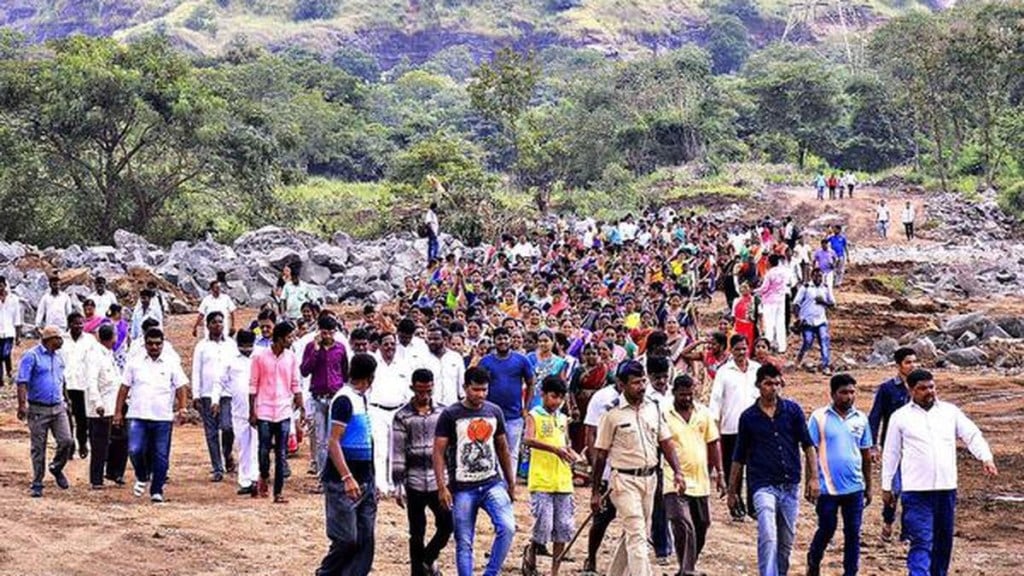The Navi Mumbai Airport Influence Notified Area (NAINA), or “Third Mumbai” as it is popularly known, is set for take-off even though the roadblocks in the form of protesting villagers have still not been fully cleared. The scale of the project is humongous — billed as a new “business magnet”, it will be three times bigger than Mumbai city and just a 25-minute drive away from the popular business district Bandra-Kurla Complex (BKC).
Vijay Singhal, vice chairman and managing director of the City and Industrial Development Corporation (CIDCO), says work is going on in full throttle. “We have already taken up town planning schemes (TPS) 1 to 12 and given tenders for road works of Rs 8,000 crore. They will begin the work in two-to-three weeks, said Singhal, adding that the total investment will be around Rs 20,000 crore.
NAINA will have various theme-based zones, including Edu-City with 10 world-class universities, Sports City, Medicine City, Knowledge City, and Innovation City. A state-of-the-art cyber security centre is also planned, which will adopt an integrated approach to combating cybercrime.
But the ambitious venture has been in the works for over 12 years. CIDCO was appointed the special planning authority in 2013 through a Government of Maharashtra notification. The project has been inordinately delayed after CIDCO faced significant pushback from landowners in various villages of the planning schemes. At the heart of the protest is CIDCO’s land pooling model, which farmers argue violates their rights. They demand that if land acquisition is inevitable, it should strictly follow the 2013 Land Acquisition Act.
CIDCO’s compensation plan is based on the 60:40 formula where the landowners get the equivalent of 40% of their land back once developed, while 60% will be part of the urban development plan.
Landowners objected to this model and five villages from a Panvel panchayat had even moved the Bombay High Court in March challenging the project’s implementation, alleging violations of the Maharashtra Regional and Town Planning (MRTP) Act. They have alleged it is a land-grabbing attempt which will leave them in the lurch with inadequate compensation. However, Singhal says that the 40% is more than 100% of their land value.
CIDCO recently announced the new, final deadline of June 30 for participation in the arbitration hearings related to TPS 8, 9, 10, 11, and 12 under the project.
The original plans for NAINA were much bigger. The CIDCO website says that the original plan in 2013 covered 560 square kilometres, containing 270 villages in Thane district (14 villages) and Raigad district (256 villages).
Singhal says that NAINA’s project size currently will be 232 square kilometres and a portion has gone to the Mumbai Metropolitan Region Development Authority (MMRDA) as well. Also, the project will cover 42 villages.
The project, which has been linked to the trans-harbour link (MRHL) or Atal Setu and the Mumbai-Pune Expressway, has been divided into 12 town planning schemes (TPS), each with a cluster of villages to facilitate development in a phased manner.
CIDCO’s Singhal added that NAINA will have all modern amenities with plug-and-play facilities and most of connectivity including optical fibre cables, electricity, and sewage lines will be underground. It will also have a metro line and 400-kilometre network of roads. “Once road work starts, we will take up other amenities,” he said.
But that’s not all. Experts believe that even if execution delays due to resident protests, compliance challenges, and environmental concerns are overcome, creating demand for the new city will remain a challenge.
“Getting people to set up shop and homes, there will be a challenge because it lacks connectivity infrastructure to other islands of Mumbai,” Gulam Zia, executive director, Knight Frank, said, adding that creating jobs and enabling connectivity to the new city will be crucial to creating demand. And all this will take time, in fact, a lot of time. Of course, patient capital will be key.
Currently, to reach the Navi Mumbai Airport from the commercial districts of Mumbai — Bandra-Kurla Complex, Worli/Lower Parel, or Colaba/Fort — can take anything between two and three hours during weekdays. While there are roads, they are packed with bumper-to-bumper traffic as people rush to reach their workplaces.
Public transport, in many ways the lifeline of a Mumbaikar, is scarce and requires multiple changeovers. “In a city where everyone is in a hurry, travelling to and from what is envisioned as Mumbai 3 is too time consuming,” a developer who did not wish to be named said.
Clearly, there are big hurdles to be crossed — not uncommon for mega projects. Like Zia says, “It took BKC nearly 40 years to become the hub it is today.” Singhal, on the other hand, says that the project will be completed in five-six years. Wishful thinking? Only time will tell.


